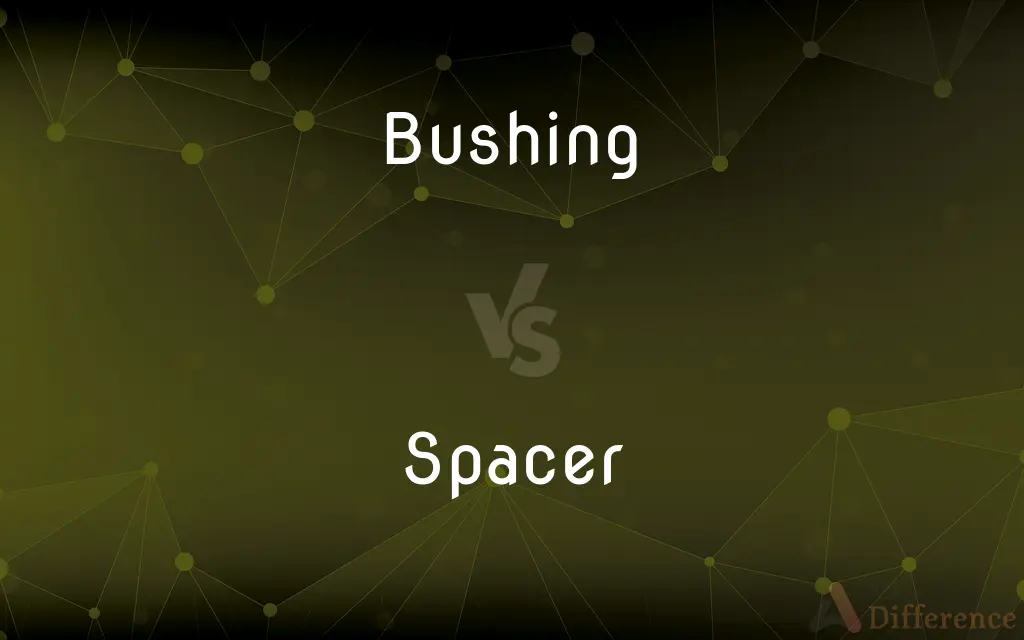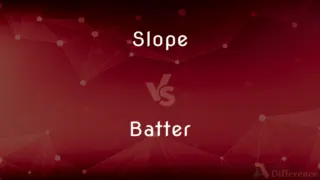Bushing vs. Spacer — What's the Difference?
By Maham Liaqat & Urooj Arif — Updated on March 26, 2024
A bushing is a type of bearing, a cylindrical lining designed to reduce friction and wear inside a hole, often used to support a rotating shaft. A spacer, however, is primarily used to create a specified distance between two parts or components.

Difference Between Bushing and Spacer
Table of Contents
ADVERTISEMENT
Key Differences
Bushing serves as a type of plain bearing, specifically designed to reduce friction and wear within a moving joint or pivot, typically made from various materials such as rubber, bronze, or plastic. On the other hand, spacers are used to maintain a specific distance between components, ensuring proper alignment, positioning, or spacing.
Bushing is often designed to be self-lubricating, incorporating materials or features that minimize the need for maintenance. This self-lubricating property is particularly beneficial in hard-to-reach areas or applications where regular maintenance is challenging. In contrast, spacers do not require such features since they do not bear loads in the same manner. Spacers can be made from a wide range of materials, including metal, plastic, or even ceramics, depending on the application's requirements, focusing solely on spacing rather than reducing friction or wear.
The selection between a bushing and a spacer is determined by the application's specific needs. For instance, when the primary requirement is to reduce friction and support rotational movement within a system, a bushing would be the preferred choice. Conversely, when the goal is to maintain a set distance or alignment between components without the need for friction reduction, a spacer is more appropriate. This distinction highlights the importance of understanding the functional requirements of the application before making a selection.
In terms of installation, bushings may require press fitting or other specialized installation techniques to ensure they are securely positioned within the assembly, providing the necessary support and friction reduction. Spacers, however, are typically simpler to install, often needing only to be placed between components to achieve the desired spacing or alignment. This difference in installation requirements reflects the distinct roles these components play within assemblies.
The choice between using a bushing or a spacer can significantly impact the efficiency, durability, and functionality of the machinery or system in which they are used. By reducing friction and wear, bushings can enhance the performance and lifespan of moving parts, while spacers can ensure the precise positioning and alignment necessary for optimal operation. Understanding these components' roles and characteristics is crucial for engineers and designers when planning and constructing mechanical systems.
ADVERTISEMENT
Comparison Chart
Primary Function
Reduces friction and wear in moving parts.
Maintains a specific distance between parts.
Application
Used in joints and pivots for smooth operation.
Used for alignment and spacing in assemblies.
Material
Often made from self-lubricating materials.
Can be metal, plastic, ceramics, etc.
Installation
May require press fitting or specialized techniques.
Simpler, often just placed between components.
Maintenance
Designed to be low or self-maintaining.
Maintenance-free, focusing on physical spacing.
Compare with Definitions
Bushing
A sleeve or lining that supports a rotating shaft.
The bushing was replaced to prevent further damage to the shaft.
Spacer
A component used to maintain a set distance between two parts.
The assembly required a spacer to ensure proper alignment of the gears.
Bushing
A lining for a hole, intended to reduce wear.
The motor's lifespan was extended by fitting it with a durable bushing.
Spacer
A device for creating distance or filling space between components.
Adding a spacer eliminated the need for adjustments in the machinery.
Bushing
A mechanical element that reduces the wear between moving parts.
Installing a new bushing can significantly reduce the machine's noise.
Spacer
A piece used in assemblies to ensure correct positioning.
The spacer was critical for maintaining the structural integrity of the building.
Bushing
A cylindrical component used in machinery to reduce friction.
Regular checks on the bushing are essential to ensure smooth operation.
Spacer
An object placed between two parts to maintain alignment.
Spacers were used in the construction to keep the panels evenly spaced.
Bushing
A type of plain bearing designed to guide and constrain motion.
The bushing ensures the rod moves smoothly without lateral play.
Spacer
An element used for spacing, not bearing loads.
The engineer recommended a spacer to solve the alignment issue.
Bushing
A fixed or removable cylindrical metal lining used to constrain, guide, or reduce friction.
Spacer
(Mathematics) A set of elements or points satisfying specified geometric postulates
Non-Euclidean space.
Bushing
(Electricity) An insulating lining for an aperture through which a conductor passes.
Spacer
The infinite extension of the three-dimensional region in which all matter exists.
Bushing
An adapter threaded to permit joining of pipes with different diameters.
Spacer
The expanse in which the solar system, stars, and galaxies exist; the universe.
Bushing
(mechanical engineering) A type of bearing, a cylindrical lining designed to reduce friction and wear inside a hole, often used as a casing for a shaft, pin or hinge.
Spacer
The region of this expanse beyond Earth's atmosphere.
Bushing
(mechanical engineering) An elastic bearing used as a type of vibration isolator, commonly made of rubber. An interface between two parts, damping the movement and the energy transmitted.
Spacer
An extent or expanse of a surface or three-dimensional area
Water covered a large space at the end of the valley.
Bushing
(mechanical engineering) A threaded bushing: a fastener element that is inserted into an object, usually to add a threaded hole in a softer or thin material.
Spacer
A blank or empty area
The spaces between words.
Bushing
(electrical engineering) A lining for an opening through which a conductor passes, providing insulation and mechanical protection for the conductor.
Spacer
An area provided for a particular purpose
A parking space.
Bushing
An adapter for joining pipes of different size.
Spacer
Reserved or available accommodation on a public transportation vehicle.
Bushing
Present participle of bush
Spacer
A period or interval of time
Within the space of a week.
Bushing
The operation of fitting bushes, or linings, into holes or places where wear is to be received, or friction diminished, as pivot holes, etc.
Spacer
A little while
Let's rest for a space.
Bushing
A bush or lining; - sometimes called a thimble. See 4th Bush.
Spacer
Sufficient freedom from external pressure to develop or explore one's needs, interests, and individuality
"The need for personal space inevitably asserts itself" (Maggie Scarf).
Bushing
An insulating liner in an opening through which conductors pass
Spacer
(Music) One of the intervals between the lines of a staff.
Bushing
A cylindrical metal lining used to reduce friction
Spacer
(Printing) One of the blank pieces of type or other means used for separating words or characters.
Spacer
One of the intervals during the telegraphic transmission of a message when the key is open or not in contact.
Spacer
Blank sections in printed material or broadcast time available for use by advertisers.
Spacer
To organize or arrange with spaces between
Carefully space the words on the poster.
Spacer
To separate or keep apart
The buildings are spaced far from each other.
Spacer
(Slang) To stupefy or disorient. Often used with out
The antihistamine spaces me out so I can't think clearly.
Spacer
To be or become stupefied or disoriented. Often used with out
I was supposed to meet her, but I spaced out and forgot.
Spacer
A person who works or lives in space.
Spacer
An object inserted to hold a space open in a row of items, e.g. beads or printed type.
Spacer
A bushing.
Spacer
(slang) A forgetful person; one who spaces out.
Spacer
(medicine) A type of add-on device used by an asthmatic person to increase the effectiveness of a metered-dose inhaler.
Spacer
(historical) An instrument for reversing a telegraphic current, especially in a marine cable, to increase the speed of transmission.
Common Curiosities
What is a bushing used for?
A bushing is used to reduce friction and wear in moving parts of machinery.
Are spacers used for friction reduction?
No, spacers are used for spacing and alignment, not for reducing friction.
Can a bushing act as a spacer?
While a bushing primarily reduces friction, it can incidentally maintain spacing in some applications.
How does a spacer function?
A spacer maintains a specified distance or alignment between components.
How are bushings installed?
Bushings may require press fitting or specialized techniques for installation.
Do spacers require maintenance?
Spacers are generally maintenance-free, focusing on physical spacing.
Can bushings be customized for specific applications?
Yes, bushings can be customized based on material and size for specific needs.
Are spacers available in standard sizes?
Spacers come in various sizes to meet different spacing requirements.
What materials are bushings made from?
Bushings can be made from rubber, bronze, plastic, and other self-lubricating materials.
How do bushings enhance machinery lifespan?
By reducing friction and wear, bushings extend the lifespan of machinery components.
What applications require spacers?
Spacers are required in applications needing precise alignment and spacing, such as in assemblies.
Can spacers be made of plastic?
Yes, spacers can be made from various materials, including plastic.
What is the difference between a bushing and a bearing?
A bushing is a type of plain bearing that reduces friction; bearings also reduce friction but are more complex in design.
Can the material of a spacer affect its functionality?
Yes, the material can impact the spacer's durability and suitability for specific conditions.
Why is precise spacing important in assemblies?
Precise spacing ensures proper alignment and functionality of components, preventing issues.
Share Your Discovery

Previous Comparison
Brunch vs. Breakfast
Next Comparison
Slope vs. BatterAuthor Spotlight
Written by
Maham LiaqatCo-written by
Urooj ArifUrooj is a skilled content writer at Ask Difference, known for her exceptional ability to simplify complex topics into engaging and informative content. With a passion for research and a flair for clear, concise writing, she consistently delivers articles that resonate with our diverse audience.













































